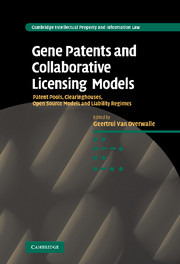 Gene Patents and Collaborative Licensing Models
Gene Patents and Collaborative Licensing Models Book contents
- Frontmatter
- Contents
- List of contributors
- Preface
- Foreword: Jean-Jacques Cassiman
- List of abbreviations
- Part I Patent pools
- Part II Clearinghouses
- 5 Clearinghouse mechanisms in genetic diagnostics. Conceptual framework
- 6 Case 3. The Global Biodiversity Information Facility (GBIF). An example of an information clearinghouse
- 7 Case 4. BirchBob. An example of a technology exchange clearing house
- 8 Case 5. The Public Intellectual Property Resource for Agriculture (PIPRA). A standard license public sector clearinghouse for agricultural IP
- 9 Case 6. The Science Commons Material Transfer Agreement Project. A standard licence clearinghouse?
- 10 Case 7. The collective management of copyright and neighbouring rights. An example of a royalty collection clearinghouse
- 11 Comment on the conceptual framework for a clearinghouse mechanism
- Part III Open source models
- Part IV Liability regimes
- Part V Different perspectives
- Part VI Summary and concluding analysis
- Index
- Titles in the series
11 - Comment on the conceptual framework for a clearinghouse mechanism
from Part II - Clearinghouses
Published online by Cambridge University Press: 14 January 2010
- Frontmatter
- Contents
- List of contributors
- Preface
- Foreword: Jean-Jacques Cassiman
- List of abbreviations
- Part I Patent pools
- Part II Clearinghouses
- 5 Clearinghouse mechanisms in genetic diagnostics. Conceptual framework
- 6 Case 3. The Global Biodiversity Information Facility (GBIF). An example of an information clearinghouse
- 7 Case 4. BirchBob. An example of a technology exchange clearing house
- 8 Case 5. The Public Intellectual Property Resource for Agriculture (PIPRA). A standard license public sector clearinghouse for agricultural IP
- 9 Case 6. The Science Commons Material Transfer Agreement Project. A standard licence clearinghouse?
- 10 Case 7. The collective management of copyright and neighbouring rights. An example of a royalty collection clearinghouse
- 11 Comment on the conceptual framework for a clearinghouse mechanism
- Part III Open source models
- Part IV Liability regimes
- Part V Different perspectives
- Part VI Summary and concluding analysis
- Index
- Titles in the series
Summary
Introduction
The notion of a royalty clearinghouse for biotech patents is beguilingly simple. So many problems would seem to be solved if there were a one-stop shop in which scientists could determine whether their activities were liable to infringe some particular gene patent, to determine whether any relevant genetic invention could be licensed, to pay for its use and to proceed on their voyage of scientific discovery.
Van Zimmeren's fascinating paper makes it clear, however, that it may be a long time before the dream of such a one-stop shop becomes a reality. She calls it ‘too big a leap forward’. I would go even further and suggest that there is much about the idea of a one-stop shop that is not only unachievable, but also potentially undesirable, unless appropriate standards of genetic patentability are firmly in place. Real thought must be given to whether the potential problem of the anticommons is not, after all, that too many genetic patents are granted and too few defences to infringement and compulsory licences available. If it is, then clearinghouses may even exacerbate, rather then relieve, the problem. Moreover, the analogy of a patent clearinghouse and a copyright collecting society seems to me to be a false one.
In her paper, van Zimmeren considers the advantages of the various clearinghouse mechanisms, and in particular the royalty collecting clearinghouse, in terms of their ability to meet three types of problem.
- Type
- Chapter
- Information
- Gene Patents and Collaborative Licensing ModelsPatent Pools, Clearinghouses, Open Source Models and Liability Regimes, pp. 161 - 168Publisher: Cambridge University PressPrint publication year: 2009
- 2
- Cited by


